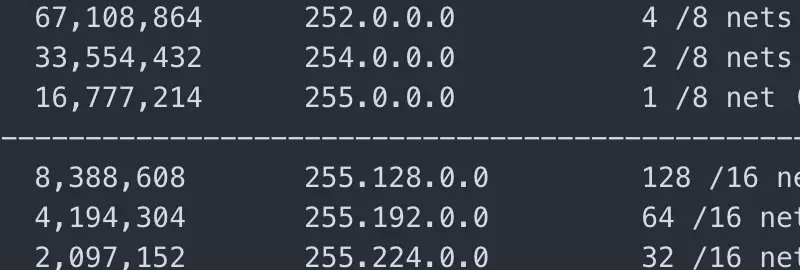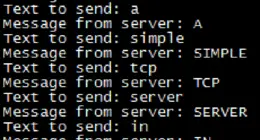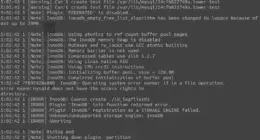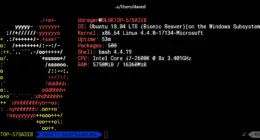Even though I’ve been working with Classless Inter-Domain Routing (henceforth known as CIDR) for years now, I always need a bit up a help remember how many addresses are in each block and how many sub-blocks fit into larger blocks. I have the following printed out for easy reference, and here it is for your geeky enjoyment:
CIDR Total number Network Description:
Notation: of addresses: Mask:
--------------------------------------------------------------
/0 4,294,967,296 0.0.0.0 Every Address
/1 2,147,483,648 128.0.0.0 128 /8 nets
/2 1,073,741,824 192.0.0.0 64 /8 nets
/3 536,870,912 224.0.0.0 32 /8 nets
/4 268,435,456 240.0.0.0 16 /8 nets
/5 134,217,728 248.0.0.0 8 /8 nets
/6 67,108,864 252.0.0.0 4 /8 nets
/7 33,554,432 254.0.0.0 2 /8 nets
/8 16,777,214 255.0.0.0 1 /8 net (Class A)
--------------------------------------------------------------
/9 8,388,608 255.128.0.0 128 /16 nets
/10 4,194,304 255.192.0.0 64 /16 nets
/11 2,097,152 255.224.0.0 32 /16 nets
/12 1,048,576 255.240.0.0 16 /16 nets
/13 524,288 255.248.0.0 8 /16 nets
/14 262,144 255.252.0.0 4 /16 nets
/15 131.072 255.254.0.0 2 /16 nets
/16 65,536 255.255.0.0 1 /16 (Class B)
--------------------------------------------------------------
/17 32,768 255.255.128.0 128 /24 nets
/19 16,384 255.255.192.0 64 /24 nets
/19 8,192 255.255.224.0 32 /24 nets
/20 4,096 255.255.240.0 16 /24 nets
/21 2,048 255.255.248.0 8 /24 nets
/22 1,024 255.255.252.0 4 /24 nets
/23 512 255.255.254.0 2 /24 nets
/24 256 255.255.255.0 1 /24 (Class C)
--------------------------------------------------------------
/25 128 255.255.255.128 Half of a /24
/26 64 255.255.255.192 Fourth of a /24
/27 32 255.255.255.224 Eighth of a /24
/28 16 255.255.255.240 1/16th of a /24
/29 8 255.255.255.248 5 Usable addresses
/30 4 255.255.255.252 1 Usable address
/31 2 255.255.255.254 Unusable
/32 1 255.255.255.255 Single host
--------------------------------------------------------------
Reserved Space:
0.0.0.0/8
127.0.0.0/8
192.0.2.0/24
10.0.0.0/8
172.16.0.0/12
192.168.0.0/16
169.254.0.0/16Of course I’m not the first one to come up with this. Modified based on the cheat sheet from Samat Jain.
Let me know if you have any improvements or suggestions.






